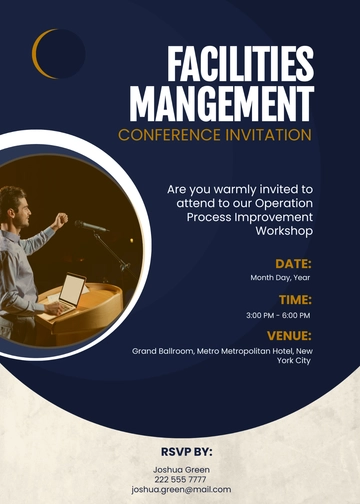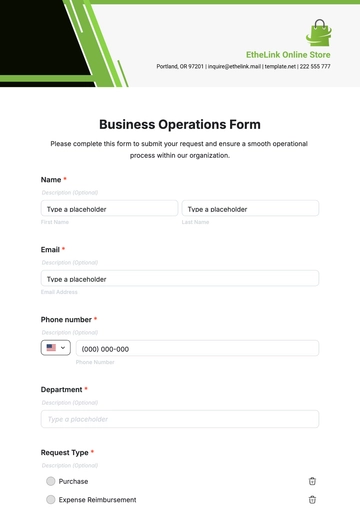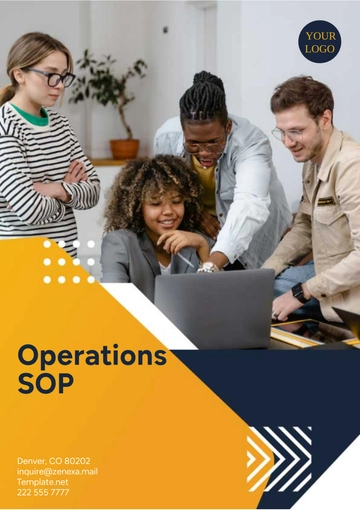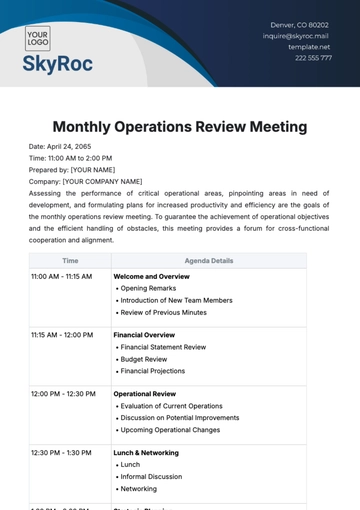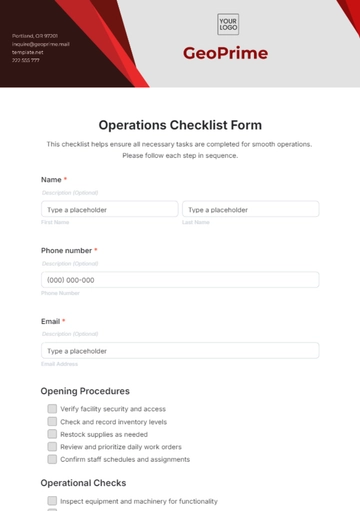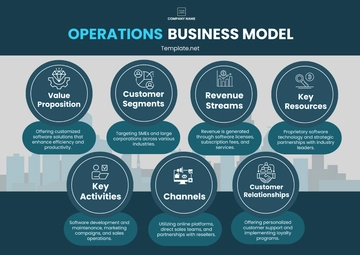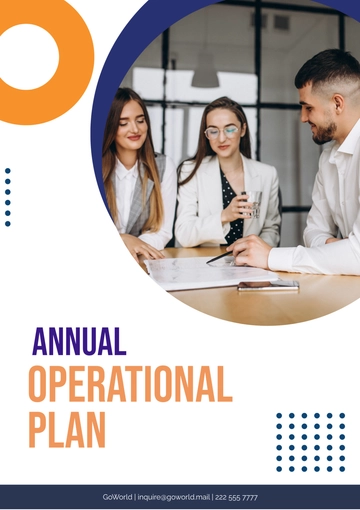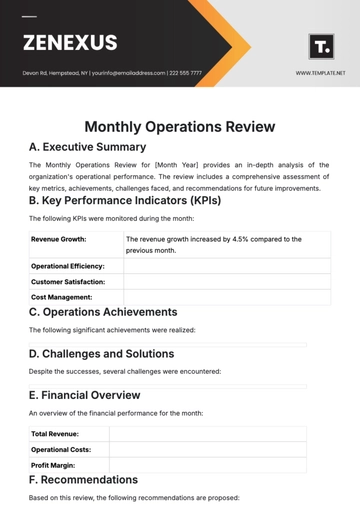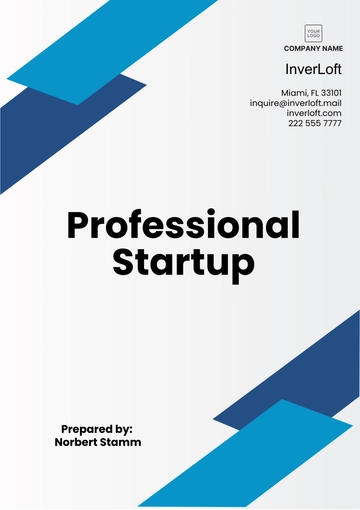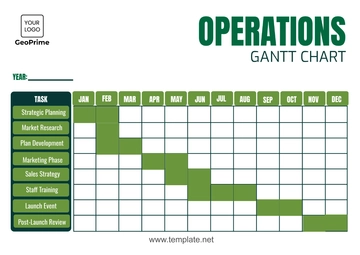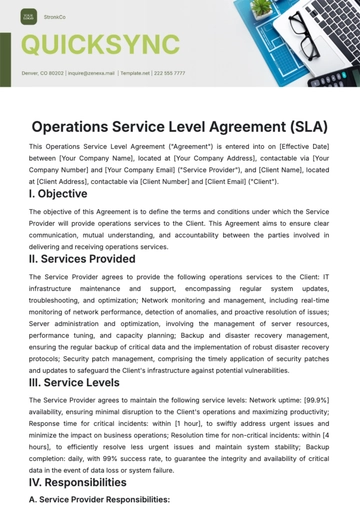Free Operations Call Center Operations Guide
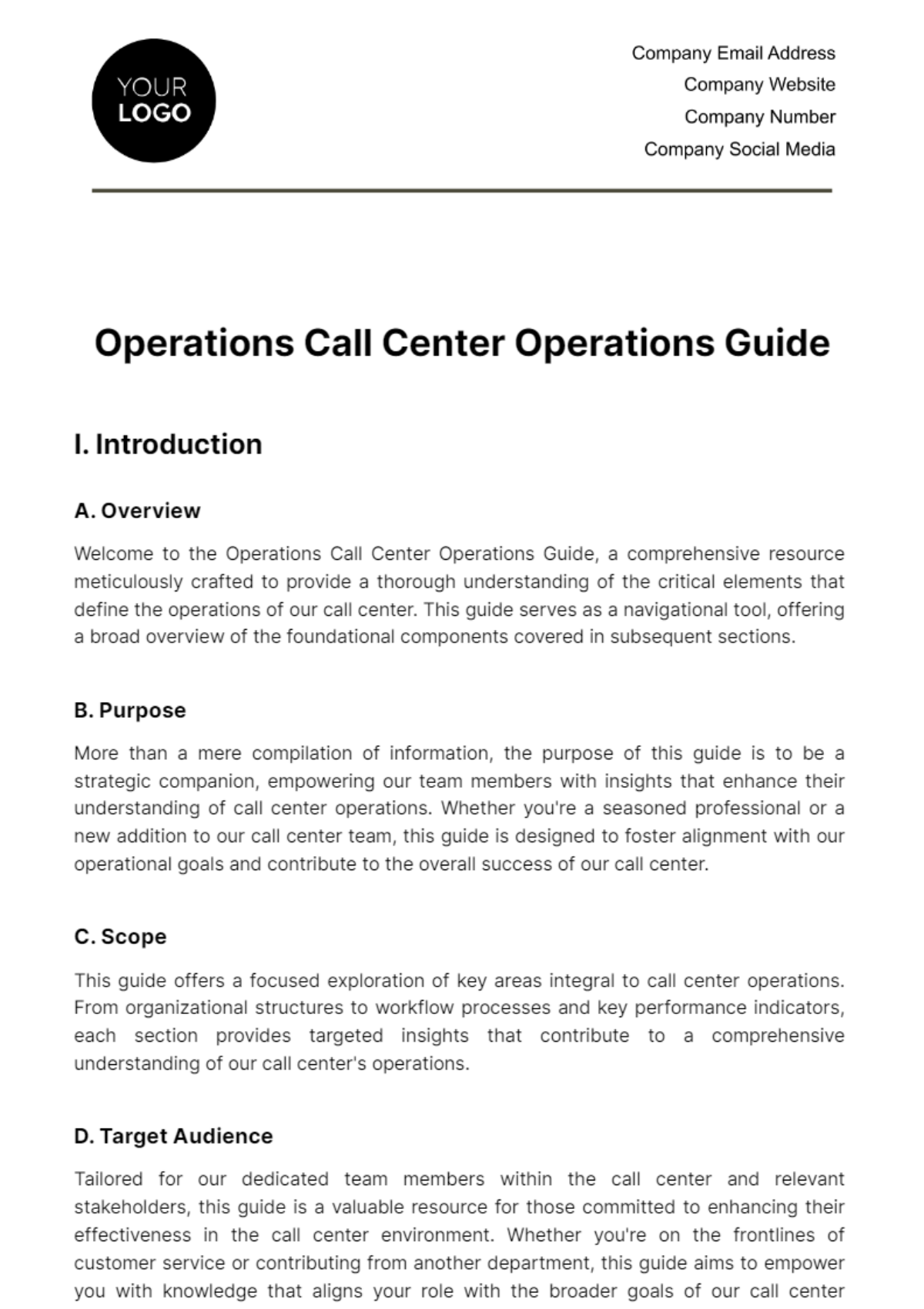
I. Introduction
A. Overview
Welcome to the Operations Call Center Operations Guide, a comprehensive resource meticulously crafted to provide a thorough understanding of the critical elements that define the operations of our call center. This guide serves as a navigational tool, offering a broad overview of the foundational components covered in subsequent sections.
B. Purpose
More than a mere compilation of information, the purpose of this guide is to be a strategic companion, empowering our team members with insights that enhance their understanding of call center operations. Whether you're a seasoned professional or a new addition to our call center team, this guide is designed to foster alignment with our operational goals and contribute to the overall success of our call center.
C. Scope
This guide offers a focused exploration of key areas integral to call center operations. From organizational structures to workflow processes and key performance indicators, each section provides targeted insights that contribute to a comprehensive understanding of our call center's operations.
D. Target Audience
Tailored for our dedicated team members within the call center and relevant stakeholders, this guide is a valuable resource for those committed to enhancing their effectiveness in the call center environment. Whether you're on the frontlines of customer service or contributing from another department, this guide aims to empower you with knowledge that aligns your role with the broader goals of our call center operations.
II. Understanding the Basics of Call Center Operations
A. Mission and Vision
Mission
At the heart of our call center operations lies a steadfast mission – to deliver unparalleled service, resolve customer issues with efficiency, and uphold uncompromising standards of quality. This mission serves as our guiding principle, inspiring every action and decision within the call center.
Vision
Our aspiration is to become a trailblazer in the industry. We envision a call center that not only meets but exceeds customer expectations, setting new benchmarks for service excellence and innovation.
B. Organizational Structure
Team Composition
The following table provides a detailed breakdown of our call center teams, outlining the diverse composition of each team and the unique roles and responsibilities that contribute to our collective success:
Team | Composition | Roles and Responsibilities |
|---|---|---|
Customer Support Team | Diverse mix of skilled agents | Addressing customer queries, providing support, and feedback |
Technical Team | Specialized technicians with IT expertise | Resolving technical issues, troubleshooting, and maintenance |
Quality Assurance Team | Experienced evaluators ensuring service quality | Monitoring and improving service delivery through evaluations |
Training Team | Trainers with expertise in various domains | Conducting training programs, fostering skill development |
The organizational structure of our call center operations is strategically designed to leverage the unique strengths of each team. The diverse composition ensures a well-rounded approach to addressing customer needs. The customer support team serves as the front line, providing immediate assistance, while the technical team addresses complex issues. Quality assurance and training teams play pivotal roles in maintaining service excellence and fostering continuous improvement. This structured approach enhances our operational efficiency and reinforces our commitment to delivering exceptional service.
Hierarchy and Reporting Lines
The following table elucidates the reporting lines and communication channels. Understanding this structure is pivotal for fostering effective communication and collaboration among team members.
Position | Reporting to | Communication Channels |
|---|---|---|
Call Center Manager | Operations Director | Direct communication with team leads and managers |
Team Leads | Call Center Manager | Regular meetings, email, and instant messaging |
Customer Support Agents | Team Leads | Daily briefings, team meetings, and digital platforms |
This breakdown offers a glimpse into the structured communication channels within our call center. The direct reporting lines from customer support agents to team leads, and further up to the call center manager, create a streamlined flow of information. Regular communication channels, including daily briefings and team meetings, contribute to a collaborative environment where feedback is exchanged efficiently.
This organized structure is instrumental in maintaining transparency, promoting effective decision-making, and fostering a culture of open communication. In essence, this not only defines reporting relationships but also establishes a framework for efficient communication. The structured approach to communication outlined ensures that information is disseminated promptly, contributing to the overall cohesion and success of our call center operations.
III. Workflow Processes
A. Inbound and Outbound Processes
Inbound Processes
Our inbound call processes are intricately designed to ensure a seamless and customer-centric experience. Here's a comprehensive breakdown of the key steps in our inbound workflow:
1.1 Customer Contact
The process initiates with the customer reaching out through various channels, be it phone calls, emails, or other communication platforms.
1.2 Issue Identification
Our skilled agents employ active listening techniques to understand and identify the core issues raised by the customer, ensuring a precise grasp of their concerns.
1.3 Ticket Creation
Upon issue identification, a dedicated ticket is promptly created in our advanced ticketing system. This centralized record becomes the nexus for tracking and efficient resolution.
1.4 Routing to Relevant Teams
The ticket is routed to the most appropriate team based on the nature of the issue. This ensures specialized attention, contributing to swift and effective resolution.
1.5 Resolution and Follow-up
Our collaborative teams work diligently to resolve the customer's concerns. Proactive follow-ups are conducted to ensure satisfaction and gather valuable feedback for continuous improvement.
Outbound Processes
Our outbound processes are characterized by proactive engagement strategies aimed at enhancing customer relations. Below is a comprehensive breakdown of our outbound workflow:
2.1 Outreach Initiatives
Outbound processes often commence with targeted outreach initiatives, ranging from service updates and promotions to conducting surveys for valuable customer insights.
2.2 Customer Engagement
Engaging customers in a positive and informative manner, creating opportunities for meaningful dialogue and addressing any queries they may have.
2.3 Follow-up Calls
Post-service interactions involve systematic follow-up calls to ensure customer satisfaction and gather feedback. This iterative process is vital for continuous improvement.
2.4 Data Recording
Each outbound interaction is meticulously recorded, contributing to our comprehensive database. This wealth of information aids in detailed analysis and strategic decision-making.
2.5 Campaign Evaluation
Regular evaluations of outbound campaigns allow us to refine our strategies, tailoring future engagements to align with evolving customer preferences.
B. Ticketing Systems and Tools
Overview of Systems
Our operational efficiency is augmented by sophisticated ticketing systems and tools. Here's an in-depth exploration of the integral components:
1.1 Ticketing Software
Advanced ticketing software is deployed for the creation, tracking, and management of customer issues. This centralized system ensures a systematic approach to issue resolution.
1.2 CRM Integration
Integration with Customer Relationship Management (CRM) systems consolidates customer information. This integration enhances service personalization and contributes to a holistic view of customer interactions.
1.3 Automated Routing
Automated routing features streamline the process of assigning tickets to relevant teams promptly, optimizing response times and ensuring efficient issue resolution.
1.4 Real-time Updates
Providing customers with real-time updates on ticket status ensures transparency. Efficient communication channels are maintained, enhancing overall customer experience.
1.5 Performance Analytics
Leveraging performance analytics tools provides valuable insights into ticket resolution times, customer satisfaction levels, and overall operational efficiency. This data-driven approach guides informed decision-making.
Efficiency Boost
The incorporation of ticketing systems and tools significantly enhances our overall operational efficiency:
2.1 Streamlined Workflows
These tools streamline workflows by centralizing customer interactions, allowing for a systematic approach to issue resolution. This streamlined process contributes to enhanced customer satisfaction.
2.2 Improved Communication
Real-time updates and automated routing features significantly improve communication efficiency. Reduced response times and proactive communication contribute to an enriched customer experience.
2.3 Data-Driven Decision Making
Performance analytics provide a wealth of data for informed decision-making. Regular analysis allows us to continually refine our operational strategies, ensuring they align with customer expectations.
IV. Customer Service Philosophy
Our customer service philosophy is rooted in principles that prioritize customer satisfaction, effective issue resolution, and the creation of positive and lasting experiences. Here, we delve into the core tenets that define our approach to customer service:
A. Customer-Centric Approach
Holistic Understanding
We embrace a customer-centric approach by developing a holistic understanding of our customers' needs, preferences, and pain points. This ensures that our services are tailored to meet their expectations.
Proactive Engagement
Anticipating customer needs, we proactively engage in meaningful interactions. Whether addressing concerns or providing information, we aim to exceed expectations and foster long-lasting relationships.
Personalization
Recognizing the uniqueness of each customer, our interactions are personalized. This personalized touch enhances the overall customer experience, contributing to a sense of value and appreciation.
B. Effective Issue Resolution
Timely Response
We prioritize timely responses to customer queries and concerns, understanding that prompt attention is crucial for customer satisfaction. Our commitment to efficiency is reflected in our swift issue resolution processes.
Empowered Teams
Our teams are empowered with the authority and resources needed to resolve issues effectively. This empowerment fosters a sense of ownership and accountability, ensuring that customer concerns are addressed comprehensively.
Continuous Improvement
We view each customer interaction as an opportunity for improvement. Regular feedback loops and post-resolution analysis contribute to continuous refinement of our processes, elevating the quality of our issue resolution over time.
C. Positive Customer Experiences
Memorable Interactions
Beyond issue resolution, we strive to create memorable interactions. Our goal is to leave a positive and lasting impression on customers, turning routine transactions into moments that resonate.
Emphasis on Empathy
Empathy forms the bedrock of our customer interactions. Understanding and acknowledging the customer's perspective allows us to connect on a deeper level and build trust.
Consistent Service Excellence
Consistency is key to creating positive customer experiences. We maintain high service standards across all interactions, ensuring that every customer, regardless of the nature of their inquiry, receives exceptional service.
V. Key Performance Indicators (KPIs)
In our pursuit of operational excellence, Key Performance Indicators (KPIs) are the compass guiding our journey. The following table unveils a comprehensive overview of the strategic metrics that define and refine our call center operations:
KPI | Measurement | Significance |
|---|---|---|
Call Resolution Rate | Percentage | Reflects the efficiency of resolving customer issues. |
Customer Satisfaction Score | Numeric Scale | Measures the satisfaction levels of our customers. |
Average Handle Time | Time in Minutes | Indicates the average duration of customer interactions. |
First Call Resolution | Percentage | Measures the ability to resolve issues in the first call. |
Agent Productivity | Performance Index | Evaluates the overall productivity of our call center agents. |
The Call Resolution Rate, a vital metric, gauges the efficiency of our customer issue resolution processes, ensuring that concerns are addressed promptly and effectively. Customer Satisfaction Score, measured on a numeric scale, is the litmus test for the impact of our services on customer contentment. It guides us in understanding the quality of interactions, helping us fine-tune our approach to meet and exceed customer expectations. Average Handle Time is a time-centric metric that not only indicates efficiency in addressing concerns but also plays a crucial role in resource optimization.
Moreover, First Call Resolution, another pivotal KPI, measures our ability to resolve issues in the initial interaction, minimizing customer effort and enhancing satisfaction. Lastly, Agent Productivity as a performance index provides a holistic view of our team's effectiveness, aligning individual contributions with overarching operational goals. Beyond their individual significance, these KPIs collectively shape our operational strategy. The data-driven nature of these metrics allows us to identify trends, patterns, and areas for improvement.
- 100% Customizable, free editor
- Access 1 Million+ Templates, photo’s & graphics
- Download or share as a template
- Click and replace photos, graphics, text, backgrounds
- Resize, crop, AI write & more
- Access advanced editor
Simplify call center operations with the Operations Call Center Operations Guide Template only on Template.net! Leverage the power of the AI Editor Tool ensuring the guide aligns seamlessly with your operational goals. This editable guide provides a comprehensive and customizable resource for optimizing call center efficiency. Enhance employee performance now!
